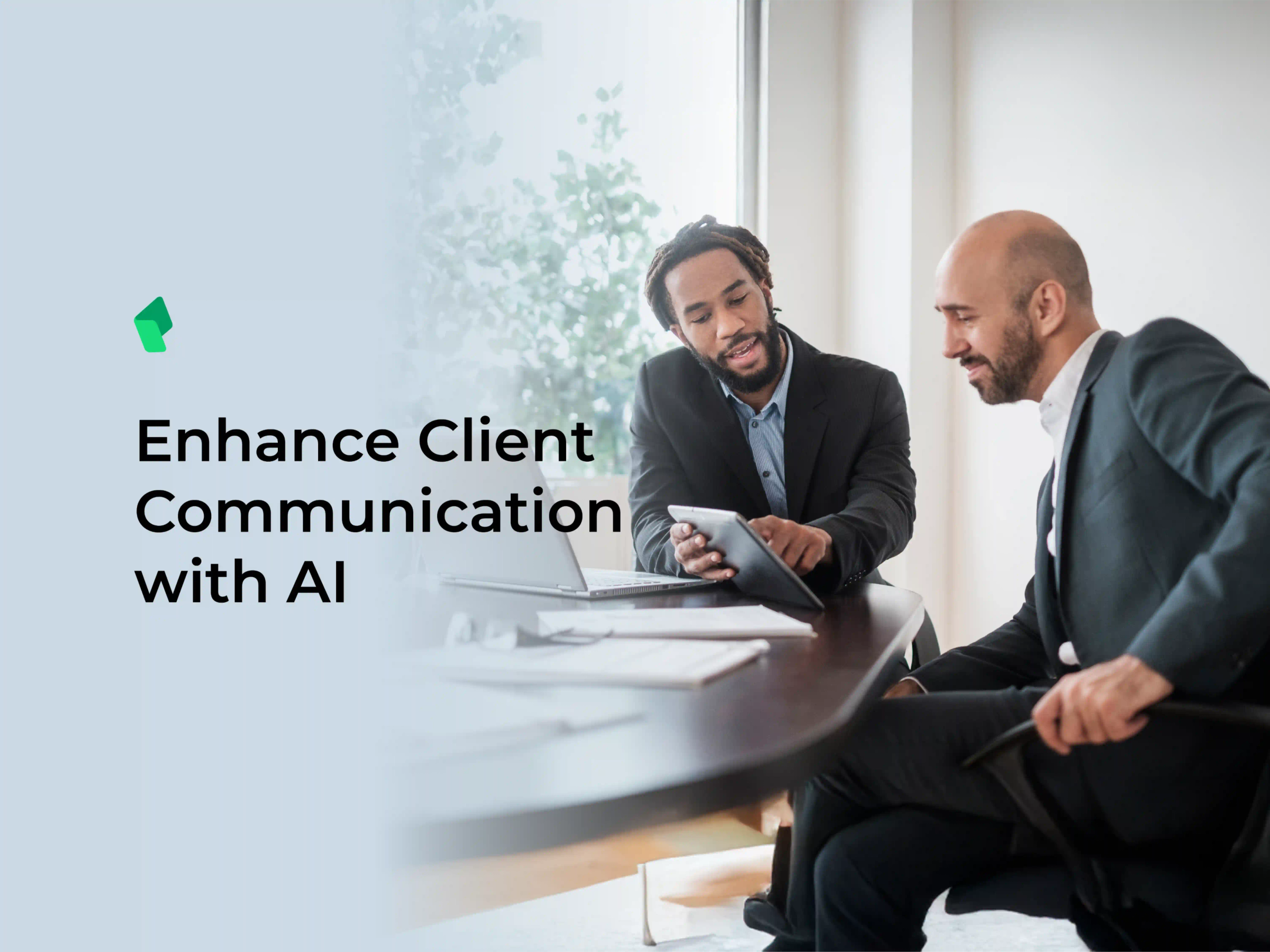AI has been an unavoidable conversation topic for a couple of years.. Throughout all of the discussion, one big question remains: how can we make AI helpful in our day-to-day lives.
The answer is a bit nuanced. AI has been transformative because of its ability to streamline mundane tasks. In fact, for legal professionals who are already struggling to complete daily tasks, this technology has the potential to give them time back.
New advances in generative AI are helping lawyers communicate with clients more effectively, in particular. However, what is the best way to use AI in a legal setting? How is AI beneficial, and when should it not be used?
Read on to find out the answers to these questions and more.
What is AI for communications?
Generative AI is often mentioned in conversations and debates about AI— but what is it, exactly?
Generative AI is an algorithmic model that uses neural networks to scan and analyze patterns in existing content to generate new content. Simply put, popular generative AI models like ChatGPT and OpenAI train themselves on existing content, learning the sentence structure and context, to output coherent text.
The main benefit of AI-generated content is it can create original content in a fraction of the time. This can improve client satisfaction since you can speed up the delivery of standard communications and updates.
AI has already been used for communication with other customer-facing industries for things like:
Chatbots and customer support
Reminders and follow-up communications
Feedback and sentiment analysis (e.g., in company call centers)
Creating and filling in document templates
Predictive analytics and forecasting (e.g., analyzing marketing and ad communications)
While AI is not a perfect fit for every type of communication, just as automated messages are not, it can help personal injury lawyers boost efficiency and client satisfaction when used correctly.
Types of AI Tools for Communications
AI is having tangible impacts on the legal industry today. In fact, many firms are already rolling out AI communications to stay competitive amidst higher client expectations.
What does this look like, practically speaking? Here are a few of the primary ways law firms are using AI client communications.
AI Text & Grammar Editing
We have all spent more time than needed agonizing over the perfect wording or catching small mistakes before communicating with a client. AI text and grammar editing tools speed up that process significantly.
AI can take the drafts of your communications and quickly assess them for things like:
Spelling and grammar errors
Tone of voice
Word choice and readability (i.e., convert any legal jargon into straightforward text)
AI-powered editing tools, like those in CASEpeer IQ, can suggest various edits that a lawyer can then review and incorporate. These tools not only help make your writing more consistent and error-free but can improve client satisfaction in the form of fewer billable hours spent on written communications.
AI Client Relationship Management
Walking clients through the complexities of client intake and the legal process is incredibly important to maintaining high client satisfaction. However, it can also be error-prone and time-consuming when done manually.
Legal AI CRM tools can help streamline the intake process by providing ways to manage communication, identify potential conflicts of interest, and handle appointments. These tools can also generate a summary of a lead based on their intake information.
Perhaps most importantly, legal AI can give you a deeper understanding of your lead management—in other words, what marketing channels are bringing you the most viable leads.
With this in mind, there are times when AI is appropriate to use in the client intake process and times when it is not. For example, AI is fantastic for contract drafting, managing documents, calendar scheduling, and automated messages. However, AI cannot replace the value of human communication. Let AI make the appointments and collect the intake information so you have more energy to nail that first impression with a potential client.
AI Content Generation
One of the most useful ways to leverage AI communication is through content generation. AI is now capable of helping draft highly-complex legal documents, including appellate briefs and memoranda of law. It is also excellent at quickly drafting accurate contracts and demand letters in a fraction of the time.
Additionally, AI content generation tools can ensure greater accuracy by running case citation checks or comparing statements from briefs with other documents, like depositions or trial transcripts.
It is worth noting that AI content is not foolproof, and should always be checked by a human. But when used for standardized documents and general communications, it can be invaluable.
AI Language Translation
Over 13% of people in the United States speak Spanish at home, making the US home to the second largest population of Spanish speakers in the world. This represents a huge opportunity for legal professionals in all fields, especially personal injury.
However, even with bilingual lawyers and legal assistants, language barriers remain in legal work—especially in the form of written communication and documents.
AI client communication solutions help lawyers overcome this hurdle with sophisticated translation tools that seamlessly localize complex texts. These tools can help lawyers provide more inclusive services to a larger number of clients.
CASEpeer currently supports Spanish to English (and vice versa) translation with additional support planned.
AI Chatbots & Virtual Assistants
Most times clients have questions that do not require advanced legal expertise to answer. In many instances, clients have common questions with relatively simple answers However, they still require a lawyer or paralegal to handle them, which can be frustrating for everyone involved.
This is another area where AI can simplify client communication. Chatbots and virtual assistants can access and review documents and case information, providing clients with quick answers to common questions. For instance, if you send over a new document to a client, they could ask an AI assistant to summarize the key points of the contract in plain language.
Benefits of Using AI for Client Communication
While AI is not the end-all-be-all solution to operational challenges and shifting client expectations, it does have some distinct benefits for law firms.
Decreased Time Spent on Client Communication
Efficient and empathetic client communication is one of the most important aspects of a successful law firm. AI significantly decreases the time spent on client communication by helping you draft standard communications, check for errors, and improve readability.
While the human element will always help you stand out from the competition, AI can help boost your efficiency so you can spend more time helping clients in other ways.
Improved Responsiveness and Personalized Interactions
Digital and connected online experiences have changed customer expectations about communication speed. Over 90% of customers expect responses to business inquiries within 24 hours and to basic questions even faster.
Additionally, people are getting fed up with generic answers. AI-powered systems solve this with the ability to instantly respond to client inquiries with personalized results. These tools can even review a client’s case information and documents to retrieve specific information outside of business hours.
Challenges With Using AI in Client Communications
AI is a potential game changer for growing law firms, saving them countless hours and money on client communication and document creation. AI is not perfect, though.
AI innovators like IBM have written extensively on challenges like the infamous “AI hallucinations,” which is when an AI finds nonexistent patterns in data and produces inaccurate answers. This means human involvement is still essential, especially when AI assists with complex tasks like medical chronologies.
To understand how AI can help you, you must understand its limitations. AI struggles in a few key areas:
Understanding Language Nuances: AI is exceptional at finding patterns in large amounts of data and handling simple communications and tasks. However, it is not a replacement for real-world experience and struggles to understand subtle context, making it a bad fit for any nuanced analysis.
Handling Complex Queries: AI is great at answering simple questions and doing basic information retrieval — but it cannot be relied on for queries that are open to interpretation or require more expertise.
Data Privacy Concerns: AI is not a person — but it is a system with access to confidential client information, which opens its use up to ethical scrutiny. For example, under HIPAA rules, AI is considered a subcontractor or business associate.
Overall, AI will not be replacing lawyers or paralegals any time soon but rather enhance how they operate.
Using AI for Client Communications: Best Practices
By providing quick, accurate, and personalized responses, AI allows law firms to provide a more satisfying customer experience, which improves retention rates and loyalty. However, using AI indiscriminately may create more problems than it solves.
The solution is to use AI correctly, leveraging its strengths while avoiding the potential ethical and reputational pitfalls that can result from its weaknesses.
1. Identify Appropriate Use Cases
The first step in using AI client communication at your law firm is figuring out the best ways to use it. AI excels at simple messages, making it ideal for things like:
Basic customer support
Lead generation and lead nurture
Personalized messaging
Document summaries
Scheduling and calendar management
Drafting communications
When using AI in communication, let your clients know that details like summaries are being generated by AI. Also, if they have further questions, provide details on how to contact your office.
2. Integrate with Current Systems
Legal AI tools are only helpful if they can actually use relevant information from your documents, processes, and clients. Make sure the AI tools you use integrate with your case management, CRM, and legal billing software. This way, you will get a consistent experience across all of your client communication channels.
3. Develop Conversational Scripts
If you are using AI to handle direct conversations with customers ( like chatbots), it might be a good idea to create a conversation script. A conversation script is like a flow chart that the AI can reference when dealing with customer inquiries.
That said, you do not have to be a coder to create one. You can find templates online for chatbot customer service scripts and input answers or write your own. Some chatbot-specific tools have ways of walking you through this process as well.
Start by writing out a list of common customer questions (e.g., “Can I have a copy of X document?” or “Where can I find information on Y?”). Then, write out the answers to direct the chatbot on how to best respond.
AI Communications for Personal Injury Law Client Satisfaction
AI has a lot of potential benefits for personal injury lawyers. Chief among them is the ability to answer common client questions whenever they need it, leading to a better client experience.
Additionally, AI tools help lawyers be more proactive and ensure nothing slips through the cracks. AI tools can track important case deadlines and send out automatic statute alerts or other important alerts to both legal staff and clients.
These kinds of tools are helpful for lawyers and build trust with clients.
Use CASEpeer IQ To Improve Client Communications
AI is an exciting new frontier for legal professionals, and when used correctly, it can transform your legal processes and client communication. Using the latest advances in generative AI, you and your clients can get detailed answers on case information. Functions like AI text editing and document summaries can also make your communications clearer and more effective.
CASEpeer is embracing the latest innovations in artificial intelligence communication to enhance how personal liability practices engage with their clients. Our legal AI tools are specifically built with personal injury law firms in mind, allowing you to explore the cost and time savings they provide with less risk.
Find out more by contacting one of our legal AI experts today.
About the author

CASEpeer Team
